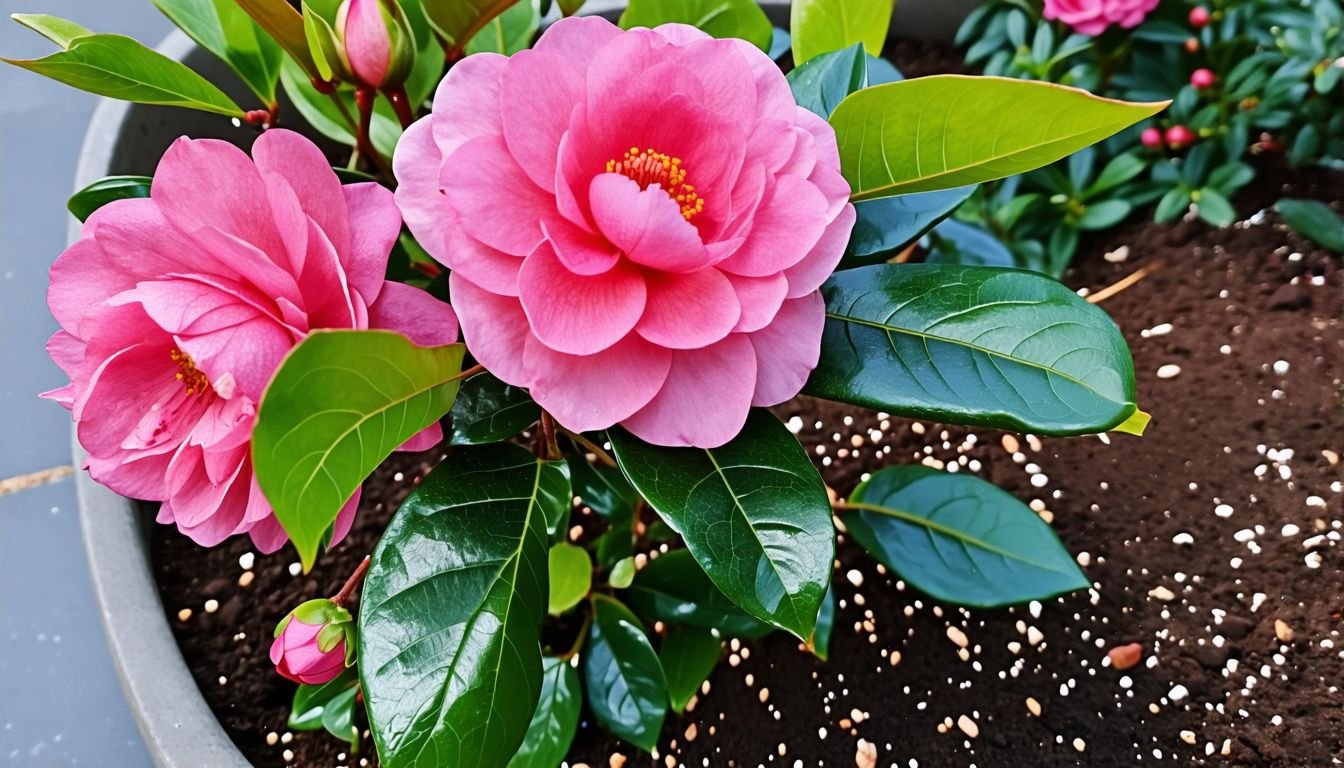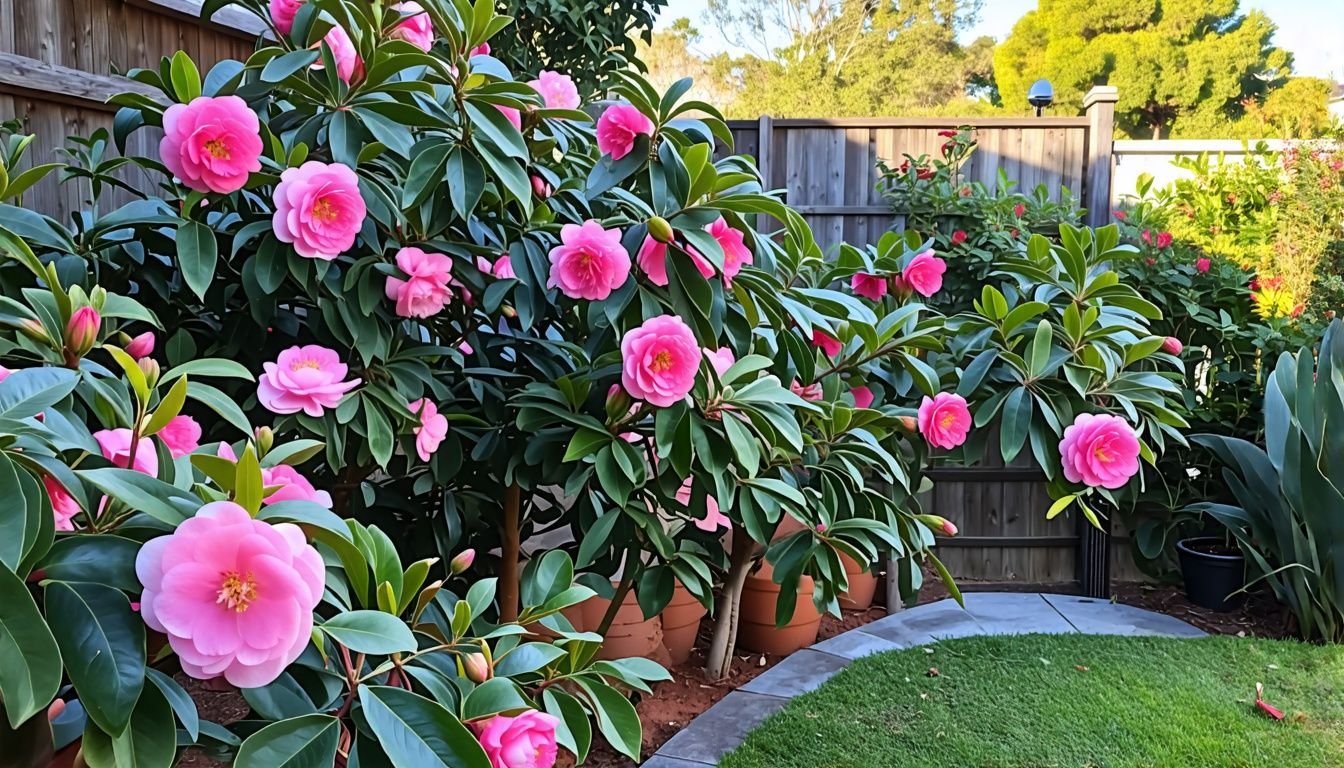G’day, fellow green thumbs! Struggling to grow camellia japonica Down Under? You’re not alone, mate. Plenty of Aussie gardeners find it a bit of a challenge to cultivate these gorgeous flowers in our diverse climate.
We’ve been there, scratching our heads and wondering why our camellias aren’t thriving.
But don’t chuck in the towel just yet! We’ve done the hard yakka researching how to grow camellia japonica successfully in Australia. Here’s a bit of insider knowledge for you – japonicas actually prefer cooler, less humid climates, making them a ripper choice for our southern states.
Our guide will walk you through choosing the perfect spot, prepping the soil, and giving your camellias the TLC they need.
So, are you keen to transform your garden with these beautiful blooms? Let’s get cracking and create a thriving camellia paradise in your backyard!
Key Takeaways
- Camellia japonica prefer cooler, less humid climates, making ’em top choice for southern Aussie states.
- Plant camellias in partly shaded spots protected from harsh arvo sun and strong winds, mimicking their natural forest habitat.
- Aim for slightly acidic soil with pH between 5.5 and 6.5, mixing in organic matter like leaf mould or compost.
- Water deeply and regularly for the first year, and feed every 1-2 weeks during growing and flowering seasons with acid-loving plant food.
- Prune after flowering to promote dense growth, and watch out for pests like aphids and scale insects, treating promptly with organic methods when possible.
Selecting the Right Location and Soil

Choosing the right spot for your camellia is key. We’ll show you how to pick the perfect place and prepare the soil for your plant to thrive.
Choosing the ideal exposure to sun and shade
Camellias thrive in the right balance of sun and shade. We’ve found that a partly shaded spot, protected from harsh afternoon rays and strong winds, works best for most varieties. This setup mimics their natural habitat under forest canopies.
Japonicas, in particular, prefer cooler climates with less humidity, making them ideal for Australia’s southern states.
Sasanqua Camellias stand out as the toughest of the bunch. These beauties can handle full sun exposure, giving Aussie gardeners more flexibility in placement. For other types, we recommend a mix of dappled sunlight and shade throughout the day.
This balance helps maintain the plant’s health and promotes stunning blooms.
The right light can make all the difference between a thriving camellia and a struggling one, as many experienced gardeners often say.
Proper soil preparation is crucial for camellia success. Let’s explore how to create the perfect growing medium for these lovely plants.
Preparing soil with the right pH and nutrients
Now that we’ve covered the best spot for your camellia, we’ll discuss soil preparation. The right soil is crucial for your camellia’s growth.
We always start with well-drained, rich soil. Camellias thrive in slightly acidic conditions, so we aim for a pH between 5.5 and 6.5. To achieve this, we mix in organic matter like leaf mould or compost.
These not only adjust the pH but also boost nutrients. For an extra nutrient boost, we add a camellia-specific fertiliser. This slow-release option feeds the plant gradually, promoting healthy growth.
Mulching is our next step. We spread a layer of organic mulch around the root zone. This could be well-rotted cow manure or bark chips. Mulch helps retain moisture, suppress weeds, and slowly break down to feed the soil.
It’s beneficial for both us and our camellias.
Planting and Initial Care
We start with proper planting techniques to give our camellias the best chance. This means digging a hole twice as wide as the root ball and mixing in plenty of organic matter.
Once planted, we focus on essential early care. Regular watering and light feeding with a slow-release fertiliser help our new camellias settle in and thrive.
Proper planting techniques for optimal growth
Planting Camellia Japonica correctly sets the foundation for its future growth and beauty. We’ve gathered the best techniques to ensure your camellia thrives in your Australian garden.
- Choose the right time: Plant camellias year-round, but spring and autumn offer ideal conditions.
- Prepare the soil: Dig a hole twice the size of the root ball. Mix the removed soil with compost and slow-release fertiliser.
- Check drainage: Fill the hole with water. If it doesn’t drain within an hour, improve drainage or choose a new spot.
- Position the plant: Place the camellia at the same depth it was in its pot. The top of the root ball should sit slightly above ground level.
- Backfill carefully: Gently fill around the roots with the prepared soil mix. Avoid air pockets by firming the soil lightly.
- Water thoroughly: Give your newly planted camellia a deep watering to settle the soil and eliminate air pockets.
- Mulch generously: Apply a 5-7cm layer of organic mulch around the base, keeping it away from the trunk to prevent rot.
- Support if needed: For larger specimens, use stakes to provide stability until the roots establish.
These steps will give your Camellia Japonica the best start in its new home. Next, let’s explore the essential early care tips to keep your camellia healthy and thriving.
Essential early care tips: watering and feeding
After planting your camellia japonica, proper care is crucial for its establishment and growth. We’ll guide you through essential early care tips, focusing on watering and feeding to ensure your camellia thrives in its new Australian home.
- Water deeply and regularly for the first twelve months. This helps develop strong root systems and prevents water stress.
- Apply mulch around the root zone to retain moisture and suppress weeds. Use organic materials like bark chips or leaf litter.
- Feed camellias every 1-2 weeks during growing and flowering seasons with a suitable plant food. Choose fertilisers designed for acid-loving plants.
- Monitor soil pH, aiming for slightly acidic conditions. If needed, adjust with iron supplements to prevent iron deficiency.
- Watch for signs of pests like aphids and scale insects. Treat promptly to avoid issues like sooty mould on leaves.
- Protect young plants from harsh sun exposure. Use shade cloth or plant under partial shade of larger trees.
- Prune lightly after flowering to maintain shape and encourage bushier growth. Use clean, sharp secateurs to avoid damage.
- Check soil moisture regularly, especially during dry spells. Camellias prefer consistent moisture but not waterlogged conditions.
Ongoing Maintenance and Troubleshooting
We’ll guide you through the essentials of camellia upkeep. Our tips cover pruning, pest management, and solutions for common problems.
Pruning, pest control, and addressing common issues
Ongoing maintenance is crucial for healthy Camellia Japonica plants in Australia. We’ve compiled essential tips for pruning, pest control, and tackling common issues to keep your camellias thriving.
- Pruning for vigour:
- Prune after flowering to promote dense growth and more blooms
- Remove dead, diseased, or crossing branches to improve air circulation
- Shape the plant by cutting back long, straggly stems
- Pest control strategies:
- Watch for aphids, thrips, caterpillars, scale, weevils, and mitesUse Yates Scale Gun to manage aphid and scale insect infestationsApply organic pest control methods like neem oil for minor issues
- Addressing yellow leaves:
- Check for nitrogen or iron deficiency if leaves turn yellowAdjust soil pH to 5.5-6.5 for optimal nutrient absorptionApply a slow-release fertiliser formulated for acid-loving plants
- Tackling flower bud issues:
- Ensure consistent moisture to prevent bud drop
- Protect buds from frost damage with frost cloth or similar coverings
- Provide adequate nutrients to support bud development and opening
- Managing fungal problems:
- Look out for sooty mould and grey mould on leaves and flowers
- Improve air circulation by thinning dense growth
- Apply fungicides as a last resort, following package instructions
Now, let’s explore the stunning variety of Camellia Japonica cultivars available in Australia.
Exploring the Beauty of Camellias in Australia
We Australians adore camellias for their stunning blooms and versatile nature. Japonica camellias captivate us with their glossy dark green foliage and eye-catching single or double flowers.
These beauties start their show in late autumn, painting our gardens with vibrant colours during the cooler months. Sasanqua camellias, on the other hand, kick off the flowering season in mid-autumn.
They’re incredibly adaptable, serving as hedging plants, small feature trees, or even groundcover varieties.
Our love for camellias extends beyond their ornamental value. The Camellia sinensis, or tea plant, holds a special place in our gardens. We grow these for their leaf tips, perfect for brewing a delightful cuppa.
For those seeking larger blooms, reticulata camellias steal the spotlight from late winter to mid-spring. Their massive flowers are a sight to behold, adding a touch of grandeur to any Aussie garden.
Camellias are the jewels of the winter garden, bringing colour and life when we need it most.
Conclusion
Camellias bring joy to Australian gardens with their stunning blooms. These plants thrive with proper care and attention. Our tips will help you grow healthy, vibrant camellias. Enjoy the beauty of these flowers in your own backyard.
With patience and love, your camellia will flourish for years to come.
FAQs
1. What types of camellias grow well in Australia?
Camellia japonica, sasanqua, and reticulata thrive in Australian gardens. These shrubs make great hedges or ground cover. Some varieties are even drought tolerant.
2. How do I care for camellias in my garden?
Camellias need acid soil and good drainage. Use a special potting mix for best results. Water them regularly. Protect them from harsh sun. Feed them with plant nutrition made for acid-loving plants.
3. Can I grow camellias in pots?
Yes, camellias grow well in pots. Choose a large pot with drainage holes. Use a quality potting mix. Water often. Place in partial shade. Prune to keep the shape you want.
4. How do I use camellias in floristry?
Camellia flowers are great for arrangements. They come in many colours. The anemone form is popular. Cut stems early in the morning. Place in cool water right away. They can last up to a week in a vase.
5. What pests affect camellias in Australia?
Watch for scale insects that produce honeydew. Powdery mildew can be a problem in damp conditions. Look for yellow veins on leaves. This might mean the plant is sick. Ask at garden centres for safe treatments.
